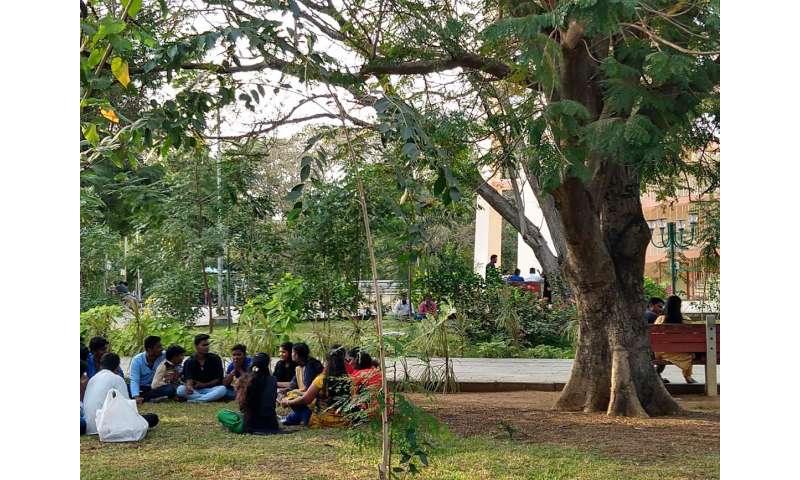Public parks guaranteeing sustainable well-being
by Science X staff
An international team led by the University of Geneva (UNIGE) has ascertained how green spaces contribute to the well-being of city-dwellers. The research shows that parks play an essential role in the well-being of individuals, regardless of their social class, and that they cannot be replaced by other venues where people meet, such as shopping centers. When these parks are closed—as during the COVID-19 pandemic—it intensifies inequalities in well-being.
Public parks are many things to many people: a space devoid of domestic chores and patriarchal expectations, a spot to cultivate friendship or love, a place where you can experience a feeling of freedom that is absent elsewhere, an opportunity to "visit" trees from a country you have not seen in a long time, a way of being part of a group while sitting alone on your bench—or even the perfect setting for running a small business to help you get by. Public parks are all this and much more if we're to believe the inhabitants of four Asian mega-cities—Chennai, Singapore, Manila and Shanghai—who were interviewed as part of a recently-published study. Green spaces, we learn, do much more than simply benefit biodiversity and health: they also meet numerous other essential human needs that open the door to sustainable well-being, a concept based on a combination of personal well-being and the necessities of sustainable development.
"There are many theories that try to define human well-being," begins Marlyne Sahakian, a professor in the Department of Sociology in UNIGE's Faculty of Social Sciences and the study's first author. "Instead of using subjective notions such as happiness, we used a list of nine 'protected needs' that has recently been developed by colleagues from the University of Basel. These needs correspond to what society can offer the population through the public sector. This list of protected needs is the result of an analysis of the scientific literature and was validated among the Swiss population and by panels of experts."
The nine capital needs
In concrete terms, the list is made up of the following nine items:
- the availability of goods that satisfy vital needs
- turning your own idea of everyday life into reality
- living in a pleasant environment
- growing as a person
- self-determination
- doing activities that you value
- being part of a community
- taking part in decisions about the future of society
- being protected by society.
Armed with this list, researchers from the four Asian cities, co-signatories of the study, asked residents about their use of public parks and the benefits they derived from them. An analysis of their responses first showed that ordinary people can assess their well-being using these protected needs, making the distinction between what they need and what they want. "This suggests that meeting human needs is a societal goal that can be discussed by diverse groups of people around the world," says Professor Sahakian before adding: "This has implications for city planning measures designed to ensure everyone's sustainable well-being for today and tomorrow. In the cities of South Asia in particular, parks—which offer a naturally cool, shaded microclimate—are a precious alternative to other leisure spaces, such as air-conditioned shopping centres."
Inclusion rather than exclusion
The research, which was supported by the Swiss Network for International Studies, also found that the use of green spaces fulfils all the protected needs to a certain degree. Three of these needs (3, 4 and 7) however, have a score that is significantly higher than the others.
"Going to the park is a social activity that requires more than just a green space, argues Professor Sahakian. People do different kinds of things in parks to meet the same need, such as exercising, chatting with other people, reading a book, meeting a group or learning about biodiversity. These are very inclusive spaces, where there is ready access for everyone, unlike what happens in shopping centres, which can operate quite a strong form of social segregation. In the immediate context of a post-COVID-19 environment, where public spending will probably be more limited than before, it is all the more important to maintain the infrastructure of the parks (water access points, toilets, trails, etc.) and to ensure access so that they can continue to meet everyone's needs."
More information: Marlyne Sahakian et al, Public Health and Well-being in Public Open Spaces through Climate Responsive Urban Planning and Design, The Journal of Public Space (2020). DOI: 10.32891/jps.v5i2.1286
Provided by University of Geneva